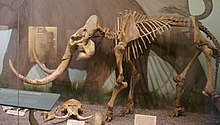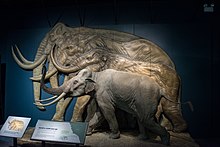Pygmy mammoth
| Pygmy mammoth Temporal range: Late Pleistocene
| |
|---|---|

| |
| Skeleton at the Santa Barbara Museum of Natural History | |

| |
| Model of a pygmy mammoth (front) at the Cleveland Museum of Natural History | |
| Scientific classification | |
| Domain: | Eukaryota |
| Kingdom: | Animalia |
| Phylum: | Chordata |
| Class: | Mammalia |
| Order: | Proboscidea |
| Family: | Elephantidae |
| Genus: | †Mammuthus |
| Species: | †M. exilis
|
| Binomial name | |
| †Mammuthus exilis (Stock & Furlong, 1928)[1]
| |
The pygmy mammoth or Channel Islands mammoth (Mammuthus exilis) is an extinct species of dwarf mammoth native to the northern Channel Islands off the coast of southern California during the Late Pleistocene. It was descended from the Columbian mammoth (M. columbi) of mainland North America, which are suggested to have colonised the islands around 250-150,000 years ago. At only 1.72–2.02 m (5.6–6.6 ft) tall at the shoulder, it was around 17% the size of its mainland ancestor. The species became extinct around 13,000 years ago, co-inciding with major environmental change and the arrival of humans in the Channel islands.
Discovery

Mammoth remains have been known on the northern Channel Islands of California since 1856. They were first reported in scientific literature in 1873.[2]
In 1994 the National Park Service called in scientists to inspect an uncovered, unidentified skeleton found on the northeast coast of Santa Rosa Island.[3] They found bones of the axial skeleton of a large land vertebrate and decided to excavate and dig up the skeleton. They recovered 90% of a mature male pygmy mammoth's skeleton.[4] The mammoth was about 50 years old when it died.[3] The small bones were preserved in life position, which represented that it had died where it was found rather than being scattered around the island. The bones were returned to the Santa Barbara Museum of Natural History.[4] After the discovery of the skeleton, a pedestrian survey of the island began. This resulted in the discovery of 160 new locations of mammoth remains, the vast majority being found on Santa Rosa Island.[3] This was the first discovery of a nearly complete specimen of the pygmy mammoth. Fortunately, the skeleton was only missing a foot, a tusk, and a couple of vertebrae. The remains were covered by a sand dune, which prevented the bones from scattering and kept them intact.[5]
Distribution

Remains of M. exilis have been discovered on three of the northern Channel Islands of California since 1856: Santa Cruz, Santa Rosa, and San Miguel, which together with Anacapa were the highest portions of the now mostly submerged superisland of Santa Rosae which existed during times of lowered sea level.[6]

Evolution
The oldest fossils of mammoths on the Channel Islands is a tusk found on a marine terrace on Santa Rosa Island, which has been dated based on surounding corals as 83,800 ± 600 – 78,600 ± 500 years old, and it is suggested that their Columbian mammoth ancestors colonised the islands either around 250,000 or 150,000 years ago, when sea levels were considerably lower than they are today.[6] During these times, the distance to the mainland was reduced to a minimum of 7 kilometres (4.3 mi),[7] though there was never a land bridge as has often historically been suggested. Mammoths like living elephants, were probably good swimmers and able to swim this distance.[6] The reduction in body size was the result of insular dwarfism as a result of the smaller land area of the Channel Islands relative to the mainland, which is observed in other island animal species, such as dwarf elephants known from islands in the Mediterranean.[8]
Description
M. exilis was on average, 1.72–2.02 m (5.6–6.6 ft) tall at the shoulders and 760–1,350 kg (1,680–2,980 lb) in weight,[9][10] making it around 17% of the body size of its 3.72–4.2 m (12.2–13.8 ft) tall, 9.2–12.5 t (9.1–12.3 long tons; 10.1–13.8 short tons) ancestor.[10][11] The limb bones of the species show isometric growth from juveniles to adults.[12]
Habitat and ecology
During the Last Glacial Period, the mega-island of Santa Rosae is thought to have been forested with coniferous trees of cypress, douglas fir and pine. Dental microwear analysis suggests that species had a primarily browsing based diet on leaves and twigs, as opposed to the more grazing focused diet of its Columbian mammoth ancestors.[8] The island exhibited a depauperate fauna that lacked large predators.[7]
Extinction
The youngest records of the species date to around 13,000 years ago. This time coincides with the reduction of the area of Santa Rosae as a result of rising sea level, the arrival of humans in the Channel Islands (as evidenced by Arlington Springs Man) and climatic change resulting in the decline of the previously dominant conifer forest ecosystems and expansion of scrub and grassland, possibly induced by wildfires. It is therefore difficult to disentangle the precise causes of its extinction.[8][13]
See also
- Mammuthus lamarmorai a dwarf mammoth species known from the Middle-Late Pleistocene of Sardinia
- Mammuthus creticus a dwarf mammoth species known from the Early Pleistocene of Crete.
References
- ^ Chester Stock and E. L. Furlong (1928). "The Pleistocene elephants of Santa Rosa Island, California" (PDF). Science. 68 (1754): 140–141. Bibcode:1928Sci....68..140S. doi:10.1126/science.68.1754.140. PMID 17772244.
- ^ Agenbroad, L.D. (2003). "New absolute dates and comparisons for California's Mammuthus exilis". Deinsea. 9: 1–16.
- ^ a b c Agenbroad, L.D.; Johnson J.; Morris D.; Stafford T.W. "Mammoths and Humans as Late Pleistocene Contemporaries on Santa Rosa Island" (PDF). Proceedings of the American Geophysical Union. Spring Meeting 2007.
- ^ a b Agenbroad, Larry D.; Don P. Morris. "Giant Island/Pygmy Mammoths:The Late Pleistocene Prehistory of Channel Islands National Park" (PDF). National Park Service Paleontological Research. 4: 35–39. Archived from the original (PDF) on 2014-02-19. Retrieved 2013-10-23.
- ^ anonymous, anonymous. "Stranded on Santa Monica". Discover. 16: 1. ProQuest 206020333.
- ^ a b c Muhs, Daniel R.; Simmons, Kathleen R.; Groves, Lindsey T.; McGeehin, John P.; Randall Schumann, R.; Agenbroad, Larry D. (May 2015). "Late Quaternary sea-level history and the antiquity of mammoths ( Mammuthus exilis and Mammuthus columbi ), Channel Islands National Park, California, USA". Quaternary Research. 83 (3): 502–521. Bibcode:2015QuRes..83..502M. doi:10.1016/j.yqres.2015.03.001. ISSN 0033-5894.
- ^ a b Kennett, D.J.; Kennett, J.P.; West, G.J.; Erlandson, J.M. (2008). "Wildfire and abrupt ecosystem disruption on California's Northern Channel Islands at the Ållerød–Younger Dryas boundary (13.0–12.9 ka)". Proceedings of the National Academy of Sciences. 104 (27–28): 2530–2545. Bibcode:2008QSRv...27.2530K. doi:10.1016/j.quascirev.2008.09.006.
- ^ a b c Semprebon, Gina M.; Rivals, Florent; Fahlke, Julia M.; Sanders, William J.; Lister, Adrian M.; Göhlich, Ursula B. (June 2016). "Dietary reconstruction of pygmy mammoths from Santa Rosa Island of California". Quaternary International. 406: 123–136. Bibcode:2016QuInt.406..123S. doi:10.1016/j.quaint.2015.10.120.
- ^ Agenbroad, L. D. (2010). ". Mammuthus exilis from the California Channel Islands: Height, Mass and Geologic Age" (PDF). Proceedings of the 7th California Islands Symposium. p. 17. Retrieved 13 June 2012.
- ^ a b Larramendi, A. (2016). "Shoulder height, body mass and shape of proboscideans" (PDF). Acta Palaeontologica Polonica. 61. doi:10.4202/app.00136.2014. Retrieved November 21, 2015.
- ^ van der Geer, Alexandra A. E.; van den Bergh, Gerrit D.; Lyras, George A.; Prasetyo, Unggul W.; Due, Rokus Awe; Setiyabudi, Erick; Drinia, Hara (August 2016). "The effect of area and isolation on insular dwarf proboscideans". Journal of Biogeography. 43 (8): 1656–1666. Bibcode:2016JBiog..43.1656V. doi:10.1111/jbi.12743. ISSN 0305-0270.
- ^ T. Htun, D.R. Prothero, J.M. Hoffman, S.M. Lukowski, V. Syverson Allometric trends in dwarfing in the extinct Pleistocene Channel Islands pigmy mammoth, Mammuthus exilis Fossil Record, 6 (1) (2018) 79
- ^ Hardiman, Mark; Scott, Andrew C.; Pinter, Nicholas; Anderson, R. Scott; Ejarque, Ana; Carter-Champion, Alice; Staff, Richard A. (2016-06-05). "Fire history on the California Channel Islands spanning human arrival in the Americas". Philosophical Transactions of the Royal Society B: Biological Sciences. 371 (1696): 20150167. doi:10.1098/rstb.2015.0167. ISSN 0962-8436. PMC 4874405. PMID 27216524.
